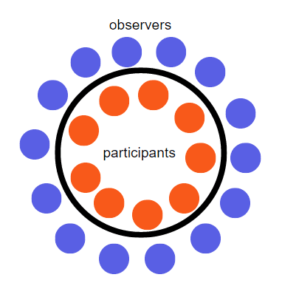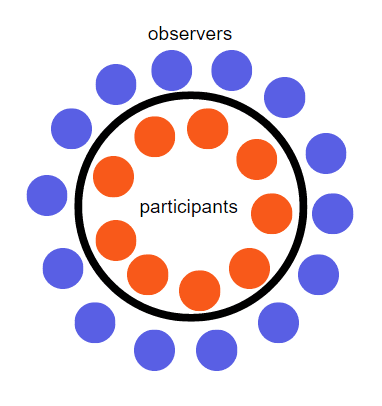Student Contributor: A. Mayfield
 Witness Circles are very similar to the idea of the Fishbowl tool, except it is a way to try and resolve larger group issues. The small inner circle consists of people that address the conflict, while the outer circle consists of observers; however, the smaller circle has an empty chair in it so that any of the observers can join in during the discussion. If the chair is occupied, the student sitting there will automatically speak next before returning to the outer circle (Smith, 2005).
Witness Circles are very similar to the idea of the Fishbowl tool, except it is a way to try and resolve larger group issues. The small inner circle consists of people that address the conflict, while the outer circle consists of observers; however, the smaller circle has an empty chair in it so that any of the observers can join in during the discussion. If the chair is occupied, the student sitting there will automatically speak next before returning to the outer circle (Smith, 2005).
This tool should be used when there is a great class problem that needs to be resolved with the help of most of the students there. The purpose is to show students how the problem effects more than just the students immediately involved. It isn’t necessarily a solution or a way to come up with one, but it can be. Witness Circles can make students feel more responsible for their peers and recognize their responsibility as an observer to harmful behavior. I’ve never really experienced a witness circle like that, but I have done the fishbowl exercise in Gus’ class as well as the acknowledgements. I think both activities relate because they make you observe your peers and recognize positive things with them and brings new ideas to the discussions.
Witness Circles best fits with the corrective phase because it is what you can do after a problem has gotten so out of hand that it needs to be addressed by the entire class, the only thing you can prepare is how you will use it and when. It hardly relates to preventative or supportive because it is the “after all of that” kind of scenario. It won’t be used to prevent problems and isn’t there in place to find solutions, rather to help everyone understand that it effects more people than you think. This tool isn’t really in place to support any behavior, but it can relate in that if students realize their responsibility and how their actions affect others it might support and encourage better behavior.
For this tool, I put that it is collaborative, and student directed. This is because it takes the work of both teacher and student for it to work. Both sides need to participate and share, and everyone in the class is involved. The teacher sets in place the structure and occasionally puts in their thoughts, but it is the students that address the problems and discuss amongst each other the most which makes it more on the student directed side of the collaborative theory.
More Information –
Tool Source: Smith. (2005). Peacemaking, Strategic Implementation of Formal Restorative Practices


